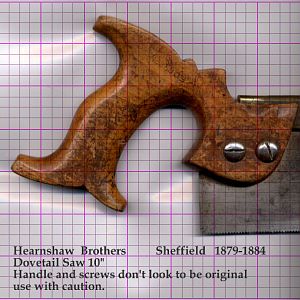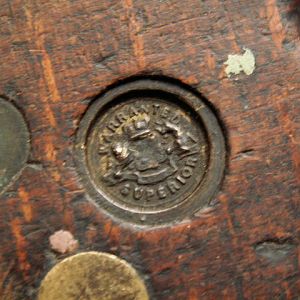Saws Making, like many other industries has it's own jargon, which as far as I am aware has been sparsely documented over the years, so in order to provide a consistent framework for discussion and research, I am presenting here a starting point, to which others can refer so that we can all agree on what that thing, you know the bump just above the whatsit, what's that called again! If you have a different name for something listed here let me know about it.
The subject of nomenclature is fraught with inconsistencies, local variations, colloquial usage, traditional usage, words invented to cover specific features and so on. It is my intention, to provide a starting point, so that we can have a common language for research and discussion. I am aware that words like "split nuts" are probably a late addition to the jargon, and would perhaps not have been understood by a 19th Century sawmaker. But, the term has gained currency through usage. And the current usage is what I am attempting to document.Research into the etymology and historic usage may provide a more complete lexicon over time.
Saws come in a bewildering array of various sizes, different tooth patterns and pitch etc. See end of this article for some more information on names of different saw types.
Starting with the basics.
The Basic Handsaw.
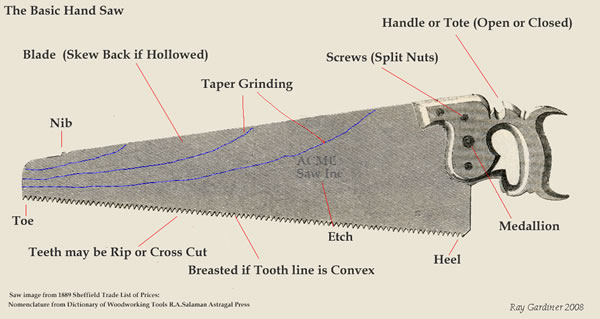
Saw image from "Sheffield Trade List of Prices 1889 Edition"
Nomenclature (with additions) from R.A.Salaman "Dictionary of Woodworking Tools"
(Keywords:Nib,Toe,Rip,Cross-Cut,Breasted,Taper,TaperGround,Etch,Heel,Medallion,Handle,Tote,Skew Back)
Ok, so if someone says they have a straight backed handsaw with eagle medallion and split nuts, slightly breasted, with intact nib, you will know exactly what they are on about. Also note that some early saws are stamped rather than etched. Whatever you do, never never ask what the nib is for, not if you value your sanity.
No moving on, my favourite
The Backsaw.
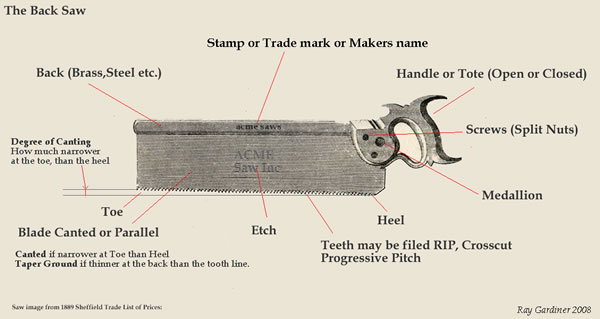
Saw image from "Sheffield Trade List of Prices 1889 Edition"
Nomenclature from various sources, Thanks to Tim Corbett - Gramercy Tools for "Canted"
(Keywords: Cant,Canted,Canting,Toe,Etch,Heel,Medallion,Screws,Split Nuts,Handle,Tote,Back,Stamp,Makers Mark)
Now, you can start to really pretend you know about saws, just say it's an open handled dovetail saw with brass back with 1/2" cant and R.Groves and Sons Trademark. With "USE" Medallion and split nuts with a beech handle. (better than saying, it's a short little saw with a funny looking handle)
Now we move into more advanced territory, starting with the Handles... First up the Closed Handsaw Handle. Fishtail or Dolphin Pattern.
The Dolphin Pattern Closed Handle
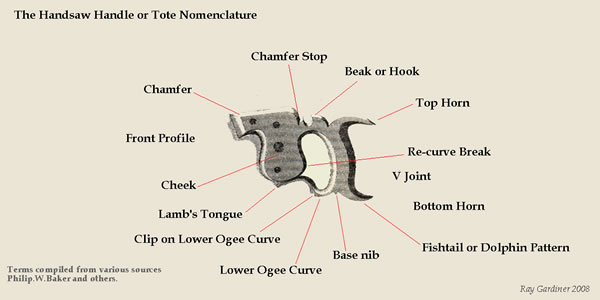
Saw image from "Sheffield Trade List of Prices 1889 Edition" digitally modified
Nomenclature from various sources, notably Philip W Baker
(Keywords: Cheek,Lamb's Tongue,Lower Ogee,Chamfer,Beak,Recurve,Bottom Horn,Top Horn,Fishtail,Dolphin,Base Nib)
Now we come to a variation on the closed handle called the London Pattern, this one has a flat bottom, rather than the "fishtail" or "dolphin" pattern.
This one however is a backsaw handle, rather than a handsaw. The grip position is higher up and more angled, but we'll get to that in a later article.
The London Pattern Closed Handle
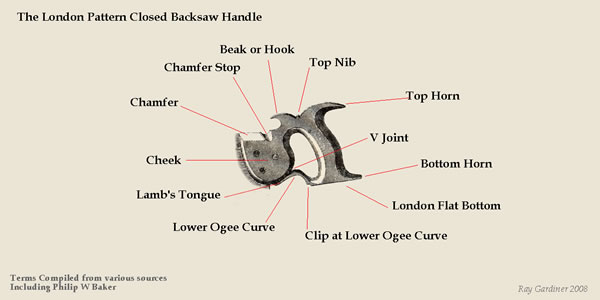
Saw image from "Sheffield Trade List of Prices 1889 Edition" digitally modified
Nomenclature from various sources, notably Philip W Baker
(Keywords: Cheek,Lamb's Tongue,Lower Ogee,Chamfer,Beak,Recurve,Bottom Horn,Top Horn,Fishtail,Dolphin,London Flat, Top Nib)
The open handled dovetail saw with a handle tailored to suit your own hand can be a joy to hold and a delight to use, and possibly the most elegant of all the saw handles.
The Open Handle
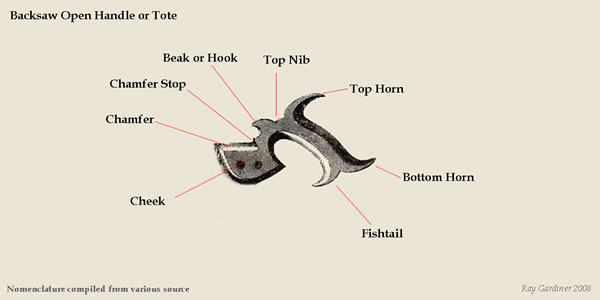
Saw image from "Sheffield Trade List of Prices 1889 Edition"
(Keywords: Cheek, ,Lower Ogee,Chamfer,Beak,Recurve,Bottom Horn,Top Horn,Fishtail,Dolphin,London Flat, Top Nib)
Saw Tooth Nomenclature
The components of a saw tooth are the face, the point or tip, the back of the tooth, and the gullet, teeth that we will consider here are standard rip and cross cut teeth, but be aware there are many other tooth patterns and variations, from Japanese pull saws to large 2 man cross cut saws. The main variables we have to define for handsaws are the pitch (how many points per inch), the rake, set, and fleam, standard gullets are constrained by the triangular (60 degree) saw files. So this is just the basics you should know for handsaws. First off the simplest is the rip saw.
The Rip Saw Tooth Pattern.

(Keywords: Gullet, Rake, Set,Kerf,Tooth)
Next, we look at the rip saws more complicated brother the cross cut saw, the main difference here is that the teeth are filed at an angle to the blade, that angle is called the "fleam angle"
The Cross Cut Tooth Pattern.
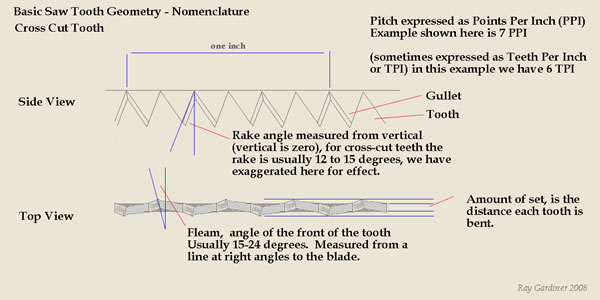
(Keywords: Gullet, Rake, Set,Kerf,Tooth,Fleam)
Choice of PPI, rake, fleam and set are dependant on whether you are cutting hard or soft timber, how thick and so on, a discussion of those choices is not within the scope of this document. Here we just tell you the names. (it is about nomenclature after all).
Now let's fill in a few gaps, the names for handsaws of various types, has changed over the years, let's look back and see what names were used in 19th Century Britain. That's what we are interested in after all.
The most often quoted authority for naming the different saw types is Holtzapffel (London 1846) so let's have a look at that first.
| Name | Length | Width at heel | Width at Toe | Points Per Inch |
| Rip Saw | 28 - 30 | 7 - 9 | 3 - 4 | 3 1/2 |
| Half Rip Saw | 26 - 28 | 6 - 8 | 3 - 3 1/2 | 4 |
| Hand Saw | 22 - 26 | 5 - 7 1/2 | 2 1/2 - 3 | 5 |
| Fine Hand Saw | 22 - 26 | 5 - 7 1/2 | 2 1/2 - 3 | 6 |
| Panel Saw | 20 - 24 | 4 1/2 - 7 1/2 | 2 - 2 1/2 | 7 |
| Chest Saw | 10 - 20 | 2 1/2 - 3 1/2 | 1 1/4 - 2 | 6-8 |
| Table Saw | 18 - 26 | 1 3/4 - 2 1/4 | 1 - 1 1/2 | 7-8 |
| Compass Saw | 8 - 18 | 1- 1/2 | 1/2 - 3/4 | 8-9 |
| Key Hole Saw | 6 - 12 | 1/2 - 3/4 | 1/8 - 1/4 | 9-10 |
| Pruning Saw | 10 - 24 | 2 - 3 1/2 | 1/2 - 1 1/4 | 4 -7 |
Table of Backsaw Names and Sizes
| Name | Length | Width |
Points per Inch |
|
| Tenon |
16 - 20 |
3 1/4 - 4 |
10 | |
| Sash | 14 - 16 |
2 1/2 - 3 1/4 |
11 | |
| Carcase | 10 - 14 |
2 - 2 1/2 |
12 | |
| Dovetail | 6 - 10 |
1 1/2 - 2 |
14 - 18 |
Compiled from R.A.Salaman "Dictionary of Woodworking Tools"
It will be immediately obvious that the names of many saws have changed since 1846, there are some that have dissapeared from general usage and some where the name has changed from earlier usage. Today's tenon saw for example is more like a carcase saw from the 19th Century. Whereas a 19th Century tenon saw would be called a mitre box saw today.
I will edit and add to this periodically, so check back every so often. Think of this as a first draft.
Ray Gardiner 2008

